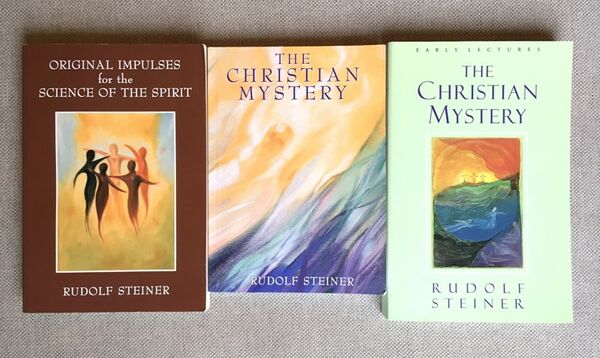Guided study approach to Christ
Introduction
This provides an explanation about the proposed study approach to the Christ Impulse and the Mystery of Golgotha, using Study Modules.
- Our approach is to provide a guided pathway, and this website is a tool along your study and learning journey. By pointing you to the right lectures in an overall logically structured framework, you will not loose your way but be able to build your insights continuously, and always come back to this site as a reference.
- The goal is to 'initialize' our base understanding, so we have a foundation to build on. In the next phases we can then continuously extend the territory covered by adding perspectives to shed light on the so-many aspects of the Mystery of Golgotha and the Christ Impulse. As we learn through the process, the interrelationships will become clearer.
- However, please appreciate this is a process that takes its time and riping. It is not because this is a website, that you can click your way around and get away with quick insights. You will have to do your own soul work by letting the study and contemplation work in and upon yourself.
Because we need to start somewhere as a first step in our intended comprehensive approach, we choose a selection of five key lectures as the best introduction to the Mystery of Golgotha (MoG). And these are for you to study.
In the next four steps we propose some 'homework' to study these "top lectures" in a specific order. This will provide a base foundation and for further study work. The proposal is that you make a logical mindmap for yourself while studying the first top three lectures, so as to have an overview for yourself of the main angles of perspectives covered.
As with a concrete foundation for a building, the quality and depth of this soul work is crucial and it is a requirement to invest in this and not rush it. Take not days but weeks, or even months. Go back to the lectures and your notes again and again. Rather than rushing ahead, use the contents of these five lectures to incubate your mind and soul. It will pay off.
Preparatory self-study
Step 1: the two central lectures
If there is one place to start, and if we were to select one single lecture only about the Mystery of Golgotha, it would be 1906-12-02-GA097. And this is the first lecture for you to study and make your own logical structured mindmap.
The second lecture is 1907-04-01-GA096 is also a reference lecture for the MoG. Together these two lectures represent an excellent starting point.
Now how to proceed? Quite practically the proposal is that you first read this page which briefly describes the intended process. Then, study the first lecture, slowly, 'parse' its contents, and draw your own high level synthetic chema (try to stick to one page) .. so you have your own schema drawing representing the structure of the various aspects covered.
Study materials:
There are at least three known versions of this lecture in English:
- the translation by Anna Meuss in the GA097 book volume, and
- the one on rsarchive (Anthroposophic News Sheets of 12 and 19 May 1946), and
- the 1998 book version by James Hindes (also called The Christian Mystery, but not the full GA volume). This book is available online in audio version here.
Below, from left to right, the base books: volumes GA096 and GA097 (both by Completion Press), and The Christian Mystery (selected lectures, Anthroposophic Press). We strongly recommend, if you are serious about this work, to buy all three volumes, they are much worth it and contain many related lectures that are 'must-study' if one wants to deepen one's understanding of the Mystery of Golgotha.
However, to facilitate online study, these two lectures 1906-12-02-GA097 and 1907-04-01-GA096 are made available below as free download in PDF form:
.
For those interested to dig a little deeper, the original German lecture transcripts are available from Steinerdatenbank. These are the files from the Rudolf Steiner Archive, used by the GA project. The files of the Uranos archive are sometimes included (not sure if this is always the case). For the first lecture, six files are available, mainly typoscripts but also one hand-written. It just gives an extra touch to the connection of what we are studying here. (PS update - unfortunately Uranos archive seems no longer online in 2020)
Step 2: the three extra lectures
The second step is to now read and study three complementary lectures of the same timeframe that enrich the image from Step 1. Again, please parse their contents for yourself so you are able to cluster subtopics.
Lecture 3 is 1907-03-25-GA096. This is a preparatory lecture that preceeded 1907-04-01-GA096 that you just studied.
Lecture 4 and 5 are 1907-03-07-GA097 and 1907-03-08-GA097 and are also preparatory 'flanker' lectures.
With these two main and three supportive lectures you have now laid a foundation for further study. We will use the logical mindmap of the territory covered by these five lectures to go into much more detail on each aspect.
Note on the original lecture contents
Given the importance of these lectures, we include the following reference. The book below is an in-depth study of these lectures based on the original lecture notes, and a thorough comparison with edits in the GA. The page link includes PDF downloads of original source materials.
www.rudolfsteinerausgaben.com/Auferstehung-des-Christentums
Resurrection of Christianity
Lectures II.1 (Berlin, March 25, 1907) and II.2 (Berlin, April 1, 1907) are based on the postscript by J. Haase written in old German script. Surprisingly, the text version of the first edition (1912) is identical to that of J. Haase, as he wrote it down in 1908.
The later version of the complete edition (GA) represents a strong expansion or editing of the original text. This is illustrated by means of text comparisons.
Step 3: synthesis
The next step is to make a synthesis of what you learned from the above five lectures, by merging the mindmaps as the topics overlap and touch eachother. It is important you go through this process and create your own pencil study notes.
Done? Congratulations! You are now ready for the journey of exploring the most startling and mind-boggling mystery in the history of humanity, and the most pivotal event in the history of the solar system evolution.
Conclusion and next steps
The following link gives an example working version of the reference schema for the above lectures, which outlines the proposed segmentation in logical Study Modules consisting of clustered topics.
The idea of the mindmap approach is that it allows us to segment the huge scope into Study Modules, and go from the raw material (lecture texts) to a more structured non-sequential approach that we can extend to a browseable website in support of your study process. Each module will deepen your understanding by adding inputs from other lectures.
We recommend that before starting this process, you pull together for yourself the contents of what you learned on each of the seven sections. Make notes, preferably hand written on paper, and study the sections from 1 to 7 so you are clear and have a personal foundation for these seven Study Modules.
Notes:
- The schema also shows, on the outskirts surrounding the lecture content, additional keywords in light grey text boxes. These contain a short keyword description for more advanced study topics (related to each of these fields). We will connect to these if we continue and extend our study. Don't let them confuse you for now, because there is no point in trying to go there if you have not build your understanding in steps by going through the first seven Study Modules.
- Important: sections 1 to 7 are of course only an arbitrary division of scope, in reality 'all is connected with all', and there is no such thing as say 10 different aspects. Therefore we should not let this division in 'cruncheable' study units get in our way: this is meant solely as a practical means to organize the study. Trust that what you develop in your soul and spirit (as a result of the study process and contemplation) knows no such artificial boundaries, as we necessarily incur here in the physical world. And it is this 'building in your soul and spirit' that ultimately matters. For more info, see Tools and practical site info > About the study process and working spiritual science
Related pages
- Proposed segmentation into Study Modules
- Christ and the Mystery of Golgotha
- Christ - base study modules 1 to 7

